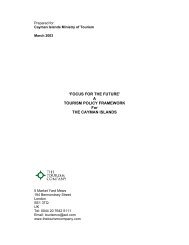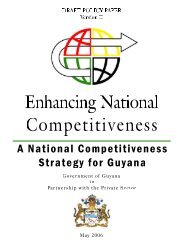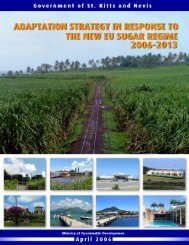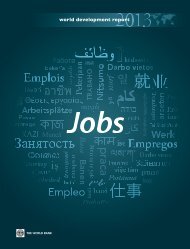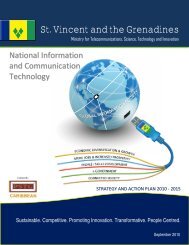Business Removing
Doing Business in 2005 -- Removing Obstacles to Growth
Doing Business in 2005 -- Removing Obstacles to Growth
- No tags were found...
Create successful ePaper yourself
Turn your PDF publications into a flip-book with our unique Google optimized e-Paper software.
20 DOING BUSINESS IN 2005<br />
Procedures<br />
Governments can reduce the number of procedures<br />
while maintaining the same level of regulation. Turkey<br />
did this. In June 2003, 7 procedures—obtaining a permit<br />
from the Ministry of Industry and Trade, making a payment<br />
to the consumers’ fund, registering at the trade<br />
registry, registering for taxes, for social security, at the<br />
chamber of commerce and at the ministry of labor—<br />
were combined into one, and delegated to the chambers<br />
of commerce (figure 3.3). Application forms were unified<br />
and shortened, and registry officers were trained in<br />
customer relations. None of the substantive requirements<br />
for the procedures were changed. 6 A new business<br />
can now be started in about a week.<br />
A year ago Colombia was tied with Belarus and<br />
Chad for the most procedures. Since then it established<br />
business help centers and concentrated several procedures,<br />
relocating representatives of each agency to the<br />
new offices. The number of procedures dropped from 19<br />
to 14—the time, from 60 days to 43.<br />
Belgium launched online registration and combined<br />
4 procedures into 1 at a company center. In so<br />
doing it entered the list of countries with fewest procedures.<br />
The office now handles responsibilities previously<br />
performed at the trade registry, social security registry<br />
and the tax registry. Time was cut from 56 days to 34.<br />
Time<br />
Eliminating or combining procedures gave the largest<br />
time savings. But some countries also cut time by reforming<br />
individual procedures. Argentina established a<br />
fast-track process for registration, reducing the time to<br />
obtain a company identification number from 14 days to<br />
FIGURE 3.3<br />
Big changes in Turkey in 2003<br />
Time<br />
Time reduced<br />
from 38 days to 9<br />
Source: Doing <strong>Business</strong> database.<br />
2003<br />
2004<br />
Number of procedures<br />
2003<br />
Procedures reduced<br />
from 13 to 8<br />
5. Sri Lanka computerized the registry office, cutting a<br />
week off of waiting time. Moldova also introduced a new<br />
electronic system at the state registration chamber, reducing<br />
delays by a third.<br />
Cost<br />
Reducing costs can be straightforward. Ethiopia did it by<br />
eliminating the requirement to publish notices in two<br />
newspapers. Costs plummeted from almost 500% of income<br />
per capita to 77%, and time fell from 44 days to 32.<br />
Albania eliminated some registration fees, almost halving<br />
cost to 32%. Georgia cut the start-up cost from 23%<br />
to 14%. The Democratic Republic of Congo reduced<br />
cost by a third, albeit to a still staggering 557% of the income<br />
per capita.<br />
Capital<br />
Scrapping minimum capital requirements is a difficult<br />
reform because it requires legislative change. France was<br />
the only economy to abolish the requirement last year,<br />
and Bosnia and Herzegovina was the only one to reduce<br />
it. And the new draft company law in Serbia and<br />
Montenegro contemplates a significant reduction in<br />
2005: from 5,000 Euro to 10.<br />
Some justify capital requirements as protecting<br />
creditors and society against damage from failing or untrustworthy<br />
businesses. But in many countries minimum<br />
capital can be paid with in-kind contributions,<br />
such as management time—hardly of value in insolvency.<br />
In others the capital may be withdrawn immediately<br />
after registration. In practice recovery rates in insolvency<br />
are no different between countries with and<br />
without minimum capital requirements. 7 The countries<br />
that developed the requirement in the 18th century—<br />
England and France—have both scrapped it.<br />
Others should follow. Cambodia shows why. It takes<br />
almost 5 times the income per capita in official fees to<br />
start a business in Phnom Penh. Also the entrepreneur<br />
needs to deposit CR20 million, or about $5,100, in a<br />
bank account during the registration process: more than<br />
17 times the income per capita. Add other official costs,<br />
and the entrepreneur needs $6,650, or 22 times the income<br />
per capita (figure 3.4). In the United States this<br />
would amount to $833,000. In reality the official fees for<br />
starting a business in New York City are $210, and there<br />
is no minimum capital requirement.<br />
High capital requirements are common in the Middle<br />
East and North Africa. Syria imposes the world’s<br />
highest, at 50 times the income per capita. But this is a<br />
20th century invention. 8 Before then, the Middle East



